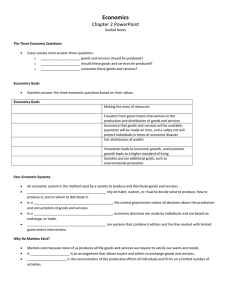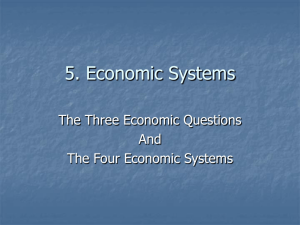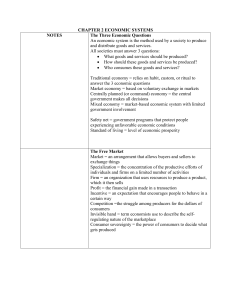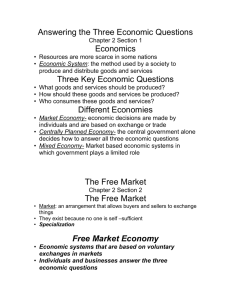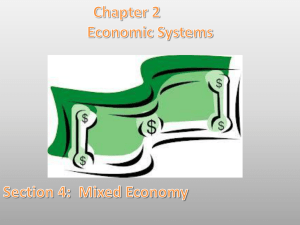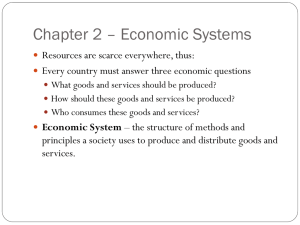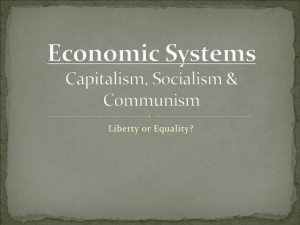Page 1 of 2 ECONOMICS STUDY GUIDE, CHAPTER TWO
advertisement
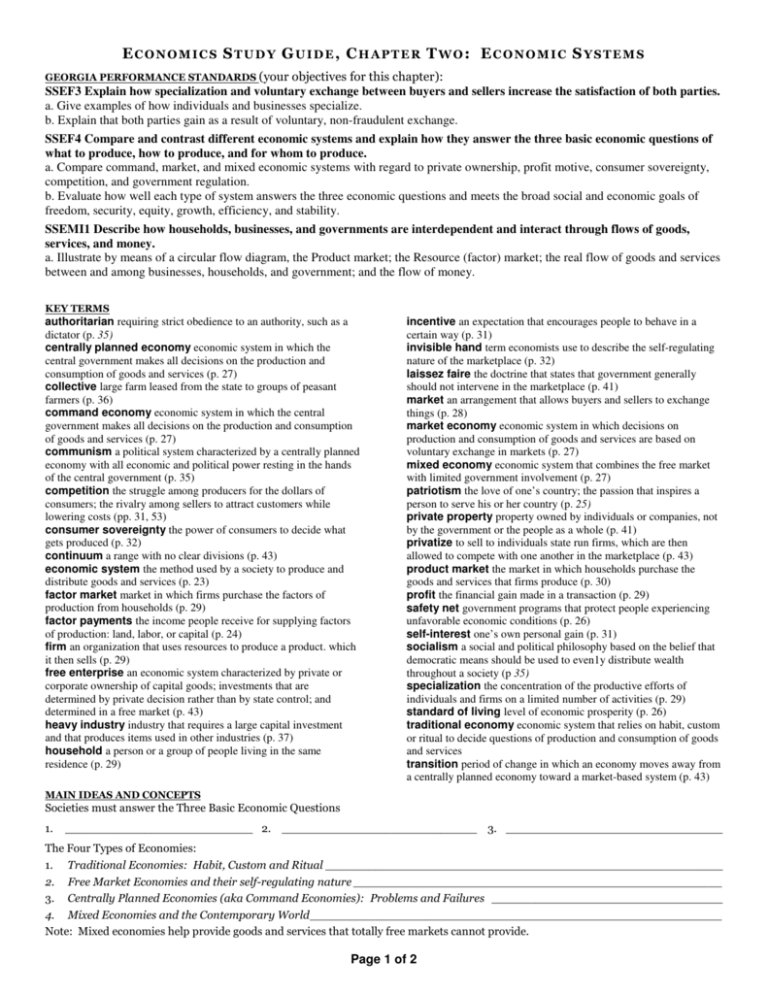
ECONOMICS STUDY GUIDE, CHAPTER TWO: ECONOMIC SYSTEMS GEORGIA PERFORMANCE STANDARDS (your objectives for this chapter): SSEF3 Explain how specialization and voluntary exchange between buyers and sellers increase the satisfaction of both parties. a. Give examples of how individuals and businesses specialize. b. Explain that both parties gain as a result of voluntary, non-fraudulent exchange. SSEF4 Compare and contrast different economic systems and explain how they answer the three basic economic questions of what to produce, how to produce, and for whom to produce. a. Compare command, market, and mixed economic systems with regard to private ownership, profit motive, consumer sovereignty, competition, and government regulation. b. Evaluate how well each type of system answers the three economic questions and meets the broad social and economic goals of freedom, security, equity, growth, efficiency, and stability. SSEMI1 Describe how households, businesses, and governments are interdependent and interact through flows of goods, services, and money. a. Illustrate by means of a circular flow diagram, the Product market; the Resource (factor) market; the real flow of goods and services between and among businesses, households, and government; and the flow of money. KEY TERMS authoritarian requiring strict obedience to an authority, such as a dictator (p. 35) centrally planned economy economic system in which the central government makes all decisions on the production and consumption of goods and services (p. 27) collective large farm leased from the state to groups of peasant farmers (p. 36) command economy economic system in which the central government makes all decisions on the production and consumption of goods and services (p. 27) communism a political system characterized by a centrally planned economy with all economic and political power resting in the hands of the central government (p. 35) competition the struggle among producers for the dollars of consumers; the rivalry among sellers to attract customers while lowering costs (pp. 31, 53) consumer sovereignty the power of consumers to decide what gets produced (p. 32) continuum a range with no clear divisions (p. 43) economic system the method used by a society to produce and distribute goods and services (p. 23) factor market market in which firms purchase the factors of production from households (p. 29) factor payments the income people receive for supplying factors of production: land, labor, or capital (p. 24) firm an organization that uses resources to produce a product. which it then sells (p. 29) free enterprise an economic system characterized by private or corporate ownership of capital goods; investments that are determined by private decision rather than by state control; and determined in a free market (p. 43) heavy industry industry that requires a large capital investment and that produces items used in other industries (p. 37) household a person or a group of people living in the same residence (p. 29) incentive an expectation that encourages people to behave in a certain way (p. 31) invisible hand term economists use to describe the self-regulating nature of the marketplace (p. 32) laissez faire the doctrine that states that government generally should not intervene in the marketplace (p. 41) market an arrangement that allows buyers and sellers to exchange things (p. 28) market economy economic system in which decisions on production and consumption of goods and services are based on voluntary exchange in markets (p. 27) mixed economy economic system that combines the free market with limited government involvement (p. 27) patriotism the love of one’s country; the passion that inspires a person to serve his or her country (p. 25) private property property owned by individuals or companies, not by the government or the people as a whole (p. 41) privatize to sell to individuals state run firms, which are then allowed to compete with one another in the marketplace (p. 43) product market the market in which households purchase the goods and services that firms produce (p. 30) profit the financial gain made in a transaction (p. 29) safety net government programs that protect people experiencing unfavorable economic conditions (p. 26) self-interest one’s own personal gain (p. 31) socialism a social and political philosophy based on the belief that democratic means should be used to even1y distribute wealth throughout a society (p 35) specialization the concentration of the productive efforts of individuals and firms on a limited number of activities (p. 29) standard of living level of economic prosperity (p. 26) traditional economy economic system that relies on habit, custom or ritual to decide questions of production and consumption of goods and services transition period of change in which an economy moves away from a centrally planned economy toward a market-based system (p. 43) MAIN IDEAS AND CONCEPTS Societies must answer the Three Basic Economic Questions 1. __________________________ 2. ___________________________ 3. ______________________________ The Four Types of Economies: 1. Traditional Economies: Habit, Custom and Ritual _______________________________________________________ 2. Free Market Economies and their self-regulating nature ___________________________________________________ 3. Centrally Planned Economies (aka Command Economies): Problems and Failures ________________________________ 4. Mixed Economies and the Contemporary World _________________________________________________________ Note: Mixed economies help provide goods and services that totally free markets cannot provide. Page 1 of 2 Economic Goals and Societal Values 1. Economic Efficiency ____________________________________________________________________________ 4. Economic Equity ____________________________ 2. Economic Freedom _____________________________________________________________________________ 5. Economic Growth and Innovation ________________ 3. Economic Security and Predictability_________________________________________________________________ 6. Other Goals _______________________________ Economies in Transition GRAPHICS Circular Flow Diagrams (inc. Product Market, Factor Market, etc.) and Flowcharts Be sure you understand these and can draw them to illustrate their usage: Flowcharts (p. 45) • Free Market Circular Flow Diagram (p. 30) • Mixed Economy Circular Flow Diagram (p. 42) Continuum of Mixed Economies (p. 43) KEY PEOPLE • Lenin, Vladimir Russian Bolshevik revolutionary leader; first head of the Soviet Union who introduced communism and central planning there • Marx, Karl communist theorist, author of Das Kapital and The Communist Manifesto • Engels, Friedrich colleague of Karl Marx, and coauthor of The Communist Manifesto • Stalin, Joseph Soviet leader; known for Five Year Plans intended to boost Soviet production • Smith, Adam Scottish philosopher known for The Wealth of Nations and the “Invisible Hand” (pp. 30-34) SAMPLE ESSAY QUESTIONS 1. 2. 3. 4. How does government participate in a mixed economy? Explain what has happened to most of the large centrally planned economies. Why has this happened? Explain why a completely free market economy would not be practical for any major country. Compare and contrast: Product Market vs. Factor Market A Continuum of Mixed Economies MOSTLY CENTRALLY PLANNED North Korea Cuba Iran China Russia MOSTLY FREE MARKET Mexico France South Africa Poland Japan Page 2 of 2 United Kingdom Canada United States Hong Kong Singapore
